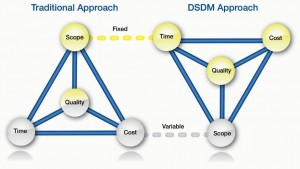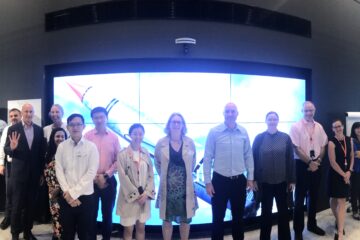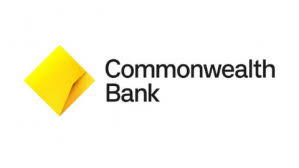“We have tried to make our projects agile, but all we have achieved is to make them fragile” … experienced this?
This post provides a brief overview of how agile solution delivery can be combined with sound project governance. Contact us for more information.
Solid project governance principles are contained in PRINCE2. DSDM provides a great example of agile solution delivery. Are they at odds with each other?
PRINCE2 was originally built around the traditional ‘iron triangle’ of time, cost and quality, where time and cost are managed (or varied) in order to bring a project to a successful conclusion. DSDM (Agile), however, has always fixed both time and cost in order to manage (or vary) scope. This leads to the ability to hit deadlines over the short, medium or long term, come what may. This next figure shows the two contrasting approaches.
In today’s environment, demand for on-time or fast time to delivery necessitates the use of agile approaches. DSDM addresses this directly, whereas PRINCE2 does so in a more indirect fashion. (PRINCE2, however, has taken this more into account since its 2009 release, which recognised the need for more guidance when using scope tolerance.)
Predictive versus convergent
PRINCE2 is often seen as a method where a lot of ‘upfront’ work is performed. Further to this, it is often felt that the more that can be done upfront, the better this is for a project.
However, this is certainly not always the case and it is important to decide how much thinking and analysis should be carried out on a project before commencing product delivery.
The choice here is based on how much to predict in advance about the required solution and how much to let emerge during the project. DSDM deliberately lets the low-level detail of a project come out later, rather than sooner, in order to achieve a more accurate solution.
A lot of decisions are based around selecting the correct level of governance and ceremony. At project initiation there will be questions such as ‘Do we run this as a full-on PRINCE2 project or do we use some of DSDM for this?’
It is not a question or ‘either/or’ – more a case of how much or how little.
Enabling iterative and incremental product delivery
Although PRINCE2 does not prevent projects from delivering in an iterative and/or incremental way, it does not explicitly support it. Integrating the DSDM lifecycle into PRINCE2 allows this to happen.
Working iteratively and delivering incrementally can easily be ‘plugged into’ PRINCE2 at the Stage Plan level and at the Work Package level as well.
Timeboxing and MoSCoW
Time-boxing is perhaps the most powerful tool in the armoury of DSDM. It operates after the controlled start and ensures that a project stays on track over the short term, thereby ensuring that it stays on track over the longer term.
With PRINCE2 this can be operated within a Work Package or a group of Work Packages.
The technique works by reducing the content of a time-box in order to protect the quality of the deliverable being created and the deadline by which it is due. All of the features or work to be done in a time-box are prioritised using the MoSCoW system. Items are classified as Must haves, Should haves, Could haves or Won’t haves (this time).
This way of working is essential when using agile. It is also essential when there is a situation in which time and cost are fixed, i.e. they have zero tolerance in PRINCE2 terms.
Shifting from ‘documentation driven’ to ‘communication driven’
There is always a need to create documents on a project but, when working in an agile way, it is important that the focus is on using the best communication channel available and not letting the process become document driven.
DSDM provides several techniques to enable a faster and more accurate understanding of the problem and the developing solution.
Facilitated workshops can be used at any time on a project, but they can be particularly useful during the controlled start, in order to get a project up and running.
Conclusion
Both PRINCE2 and DSDM are firmly established as being battle-hardened and have stood the test of time.
With most organisations looking at their own project management processes and investigating the agile ‘option’, there is a need to make this move carefully. The integration of PRINCE2 and DSDM offers numerous advantages, with little or no downside.
There are important elements to get right when making this transition or when enhancing any existing capability.




